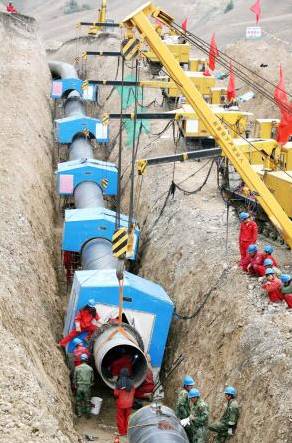West-East Natural Gas Pipeline Project
Western China's natural gas reserves are being put at 22,400 billion cubic meters, representing some 60 percent of the total for China as a whole. Many years of exploration have revealed four, national-scale gas fields in the Tarim, Qaidam, Shaanxi-Gansu-Ningxia, and Sichuan-Chongqing basins. China's natural gas is to be found mostly in the west while the market for the gas is focused to the east. The West-East Natural Gas Pipeline Project, one of the four key infrastructure projects in China's 10th Five-Year Plan (2001-05), is aimed to transfer gas from the west through to the eastern coast. The pipeline not only serves to alleviate energy shortages in the eastern regions, but also helps raise the capital investment necessary to facilitate petroleum extraction in western China.
The construction of the first pipeline started in 2000 and completed in 2004 despite complex land forms and climate conditions. The 4,000-km pipeline runs from Lunnan, Xinjiang to Shanghai, passing through 66 counties in 10 provinces, autonomous regions and municipalities directly under the central government. Natural gas transported by the pipeline is used for electricity production in the Yangtze River Delta area. There is a plan to replace use of coal by gas in Shanghai by 2010. It has provided 42 billion cubic meters of gas to 3,000 factories and nearly 200 million people over the past five years.
The construction of west segment of the second pipeline kicked off in February, 2008. The 8,704-km pipeline will cross 15 regions and carry 30 billion cubic meters of natural gas every year to Zhejiang, Shanghai, Guangdong and Hong Kong, among others. The pipeline will be made up of one trunk line and eight sub-lines. Construction of the east segment of the pipeline began in February 2009. The whole line will be operational by the end of 2011.
This project will help China increase clean energy consumption. In China, coal makes up 70 percent of the total energy consumption, 40 percentage points higher than the world average. Natural gas consumption only accounts for 3 percent of the total. The completion of the second pipeline is expected to save 11.06 million tonnes of coal every year.
